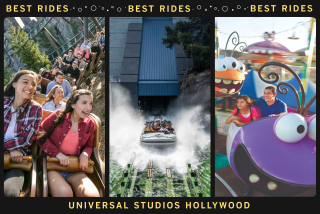‘The Sims’ Presents a World You Can Call Your Own
Better minds than mine--from Plato to Monty Python--have spent long hours pondering the meaning of life and the nature of free will. And since the dawn of the Technology Age, the key question has been whether it is possible to duplicate the human experience--to create an artificial community of thinking, learning, sentient beings composed of little more than a few million lines of code.
For those who find the question intriguing--or for those who just enjoy peeping through the blinds at the neighbors--”The Sims” offers the opportunity to cultivate a primitive version of electronic life right on their home PCs. Launching “The Sims” lets players alternate between being a voyeur and a god in a game that is at once wholesome and creepy.
The premise of “The Sims” is simple: Players control the daily lives of individual digital households. It is “Sim City” on the smallest level possible, developed by the same crew that designed that masterpiece of minutiae. The goal is to create happy, prosperous families living in material, emotional and intellectual bliss. Achieving those goals requires sound money management and a strong work ethic as well as intangibles such as an internal sense of purpose and the ability to make others feel comfortable.
When I say players direct the lives of their artificial families, I’m not exaggerating. Sim feeling scummy? Direct him or her to the shower. Bored? Find a good book or an entertaining television show. Lonely? Suggest calling friends. Big meal not sitting right? Provide directions to the bathroom.
Of course, the game would get old quick if the on-screen Sims did exactly as they are told. But these are proto-humans, and they exercise a degree of free will. Sometimes they do what they want and learn for themselves whether it was the right or wrong thing to do. It took some very smart programming to create a free-will algorithm.
But then the first hint that “The Sims” is a very smart game comes from the 100-plus page instruction manual, which includes a recommended reading list of such titles as “Notes on the Synthesis of Form” and “A Pattern Language: Towns, Buildings, Construction.” As the game launches, status messages alert users that the program is “normalizing social network” and “calibrating personality matrix.”
All of this intelligence is delivered to users through a simple interface with menus that pop up only when needed. Real-time action occupies most of the screen. In other words, players can watch the lives of their creations unfold, buy them furniture to decorate the house and even add on as the family grows.
It can be fun just to watch. Characters react to others in the game as well as to environmental circumstances. For instance, She-Sims get mad if they visit the toilet and the last man to use it forgot to put the seat down. Sims who make unwanted advances on the neighbor’s wife can find themselves in a fight. Sims who make consistently bad choices--which means Sims who don’t have thoughtful human counterparts--end up in dead-end jobs. Or just plain dead.
Playing “The Sims” is an interesting and addictive experience, one that raises all sorts of questions about who we are as individuals. Do we create the perfect families we never had? Or do we mirror our own flawed lives? Do we want the best for our Sims? Or do we torment them with loveless marriages and unfulfilling jobs? How much control do we really have over them?
And, finally, is “The Sims” just a game inside an even bigger game in which we ourselves star? Are our own human frailties some cosmic algorithm or merely the limits of disc space and processing power?
For those who care to confront those questions, “The Sims” requires a Pentium 233 with 32 mb of RAM and 300 mb of available hard drive space.
“Sega Rally 2”
The problem with “Sega Rally 2” is not that it’s a bad game. It’s just not as good as it should be. As the 128-bit follow-up to the 32-bit “Sega Rally Championship,” “Sega Rally 2” ought to be the best racer available on any console. It isn’t.
“Sega Rally 2” has a lot to recommend it.
The 16 tracks--spread across six locations as diverse as the mountains of Corsica, the sands of the Sahara and the forests of Sweden--are the game’s highlights. They wind through beautifully detailed terrain with nary a glitch, although the graphic fog sometimes seems a tad overdone. The road surfaces--from mud to gravel to packed snow--make for challenging driving in real-world rally cars made by Toyota, Peugeot and Renault.
Players can customize the cars’ steering, suspension, tires and gearing and save the settings on Dreamcast’s Visual Memory Unit for head-to-head play. And the computerized co-driver who shouts out directions at 135 mph provides important information without blathering on.
In other words, “Sega Rally 2” covers all the bases.
But in this day of ultra-realistic racers such as “Gran Turismo 2,” players should expect more. Yes, “Sega Rally 2” is a great arcade game. But long-term playability requires more intelligent options and ever greater levels of detail. “Sega Rally 2” seems content to strive for glitz over substance.
Dreamcast is the most powerful console on the market, with twice the processing juice of Nintendo 64 and four times the oomph of Sony PlayStation. And while Dreamcast designers have delivered some gorgeous scenery, they have yet to deliver anything that truly tickles the brain.
“Tomba 2: The Evil Swine Return”
This entry for Sony PlayStation is a children’s game so complex and strange that only a child can master it. On its face, “Tomba 2” appears to hold appeal to older players as well because it mixes traditional action with adventure elements. But after only a few levels, this particular older player got lost and confused.
The game follows a pink-haired jungle boy named Tomba and his pals, Charles the monkey and Zippo the bug. The original “Tomba” was a relatively straightforward side-scrolling action game that allowed players to follow multiple paths through a level and included rudimentary adventure elements, such as the ability to gain experience and new skills.
“Tomba 2” includes more adventure components, which are collected and managed through Tomba’s adventure journal. Problem is, many of the tasks Tomba must complete in his travels are bizarre and convoluted.
The ostensible goal of the game is to help Tomba find his girlfriend, Tabby, who has been kidnapped by a contingent of psychotic flying pigs.
Along the way, though, Tomba--who is armed with a blackjack--has to do things such as save a golden crab from a burning shed by jumping on giant seesaws to pump water. Each level has similarly strange tasks.
It’s all too much for an adult mind to grasp.
*
Aaron Curtiss is participating in a management training program, where he serves as assistant to the senior vice president of advertising. He has no financial dealings with the companies he covers. To comment on a column or to suggest games for review, send e-mail to aaron.curtiss@latimes.com.
(BEGIN TEXT OF INFOBOX / INFOGRAPHIC)
Essentials
The Sims
* Platform: PC
* Publisher: Maxis
* ESRB* rating: Teen
* Price: $39.99
* Bottom line: Intelligent voyeurism
Sega Rally 2
* Platform: Sega Dreamcast
* Publisher: Sega
* ESRB rating: Everyone
* Price: $49.99
* Bottom line: Smooth, but not smooth enough
Tomba 2: The Evil Swine Return
* Platform: Sony PlayStation
* Publisher: Sony Computer Entertainment America
* ESRB rating: Everyone
* Price: $39.99
* Bottom line: Tough to follow
*Entertainment Software Ratings Board
Next Week: Crazy Taxi,” “Cyber Tiger,” “Mario Party 2” and “Tiger Woods PGA Tour 2000”
More to Read
The biggest entertainment stories
Get our big stories about Hollywood, film, television, music, arts, culture and more right in your inbox as soon as they publish.
You may occasionally receive promotional content from the Los Angeles Times.










